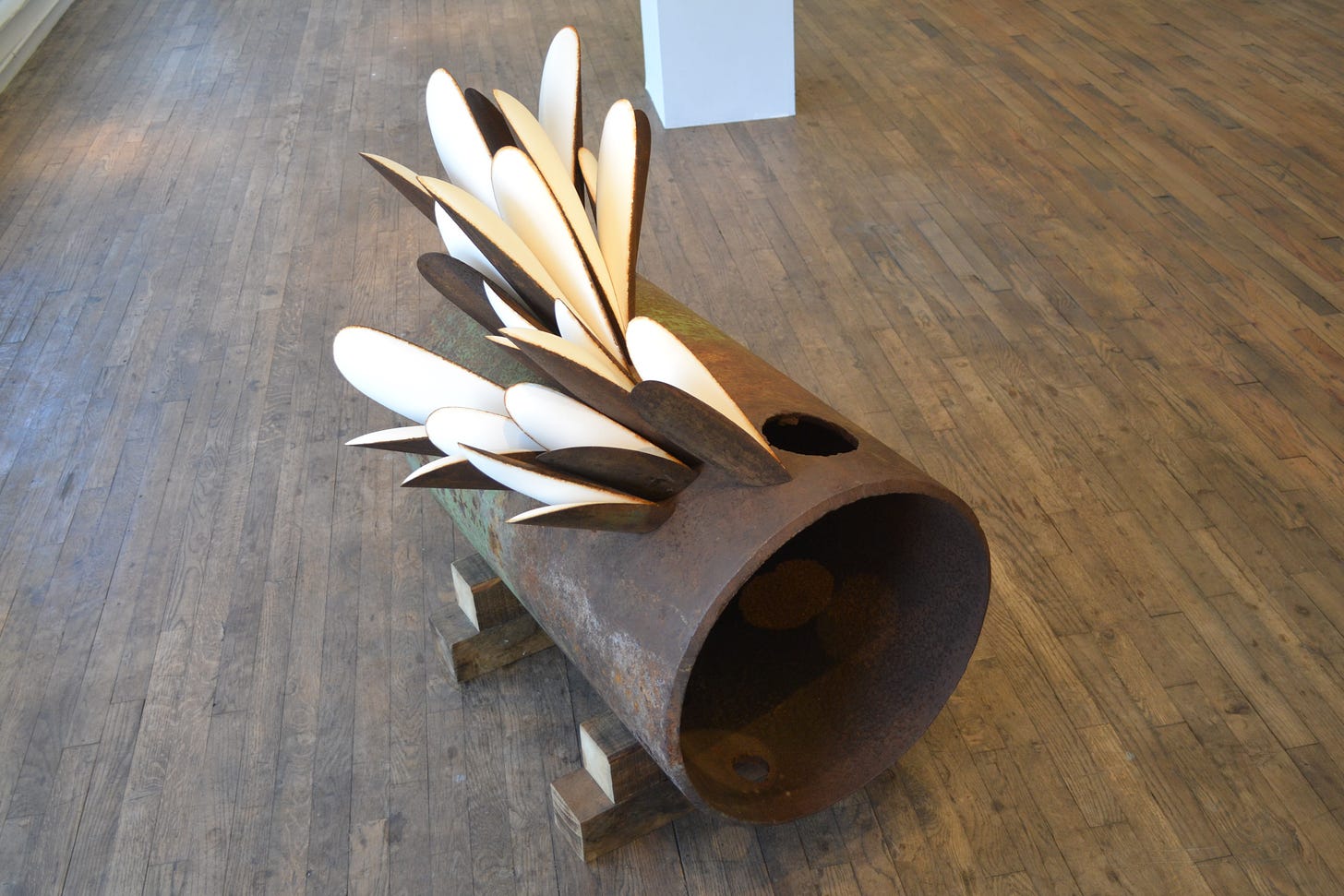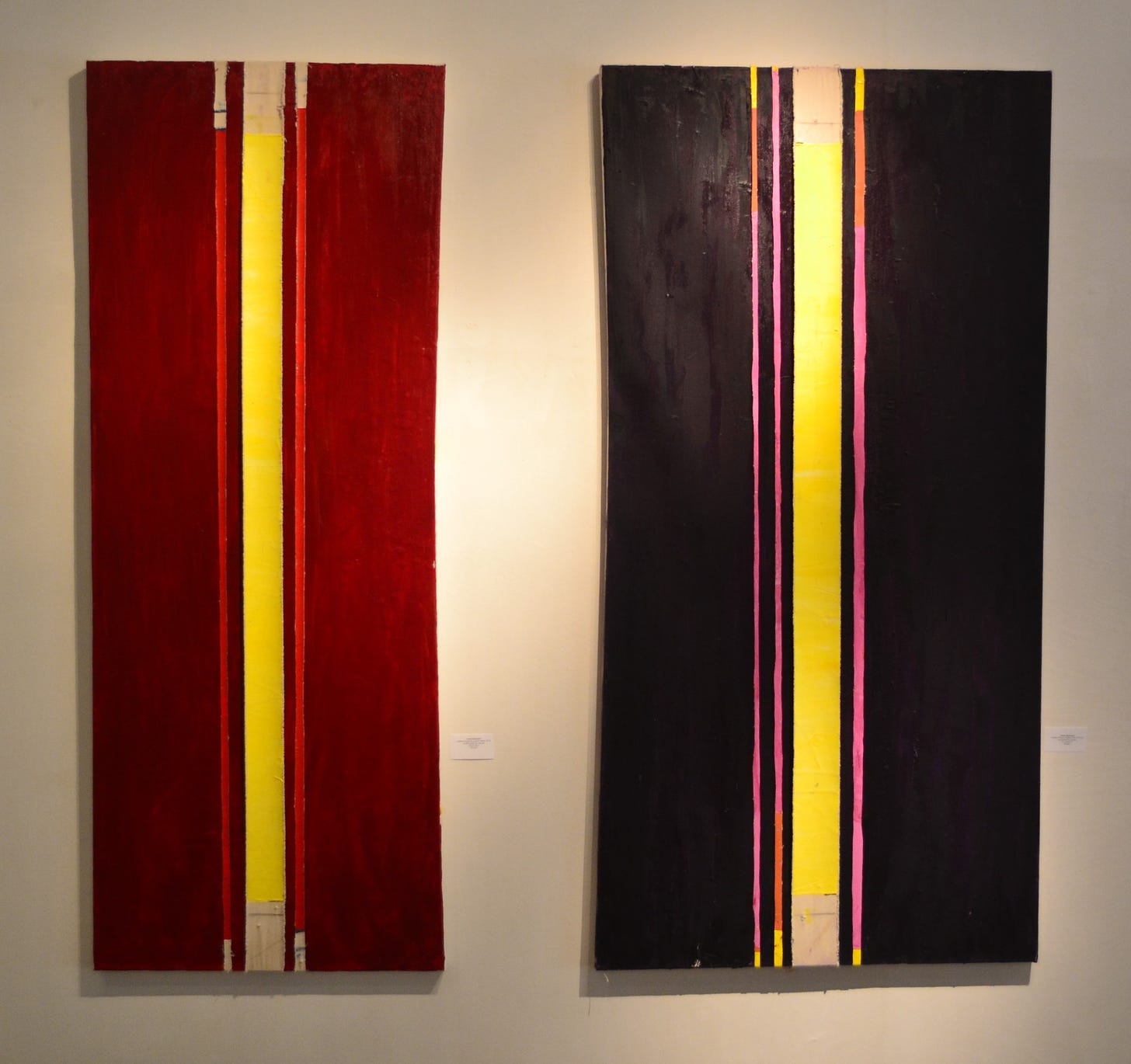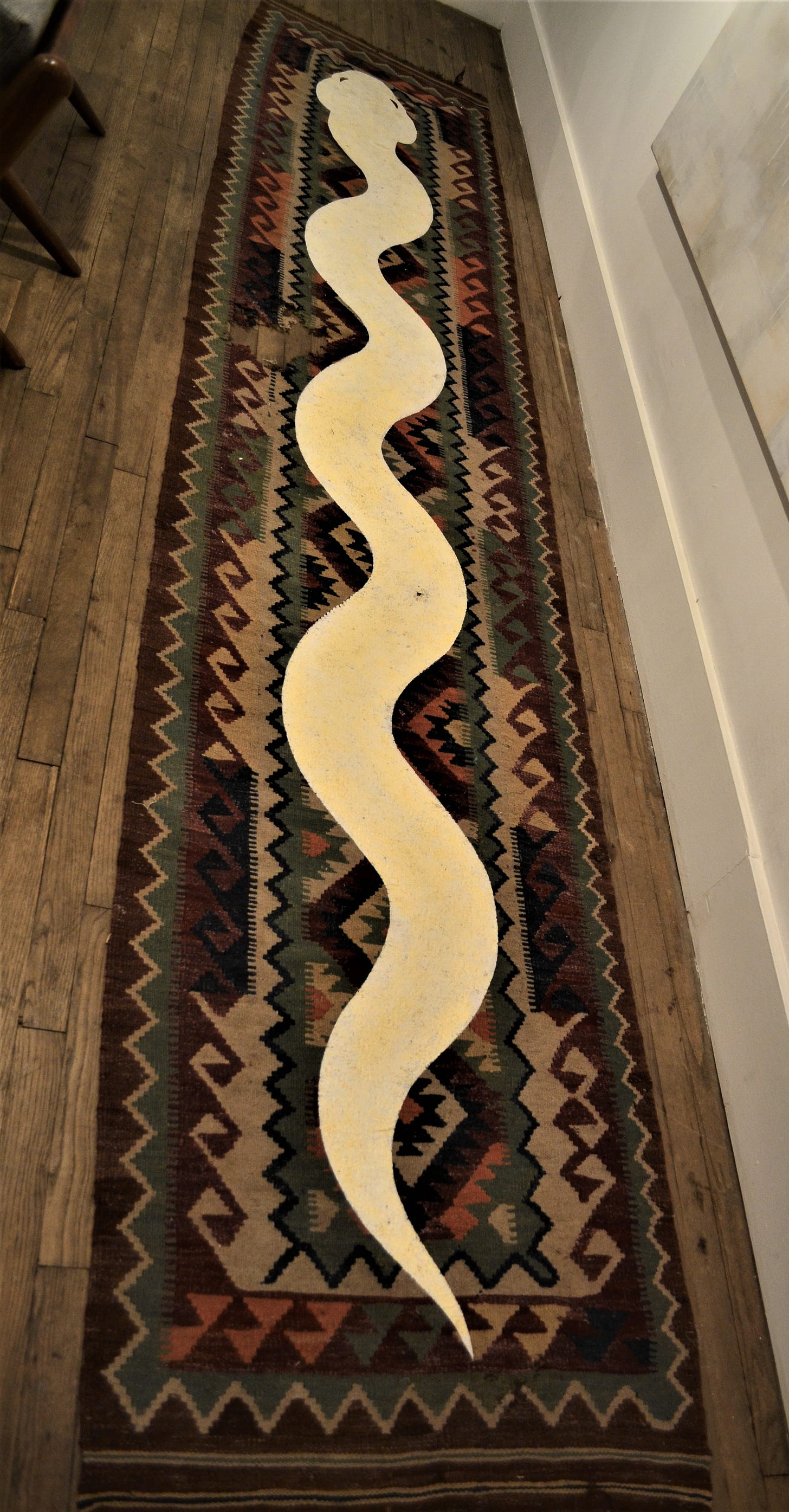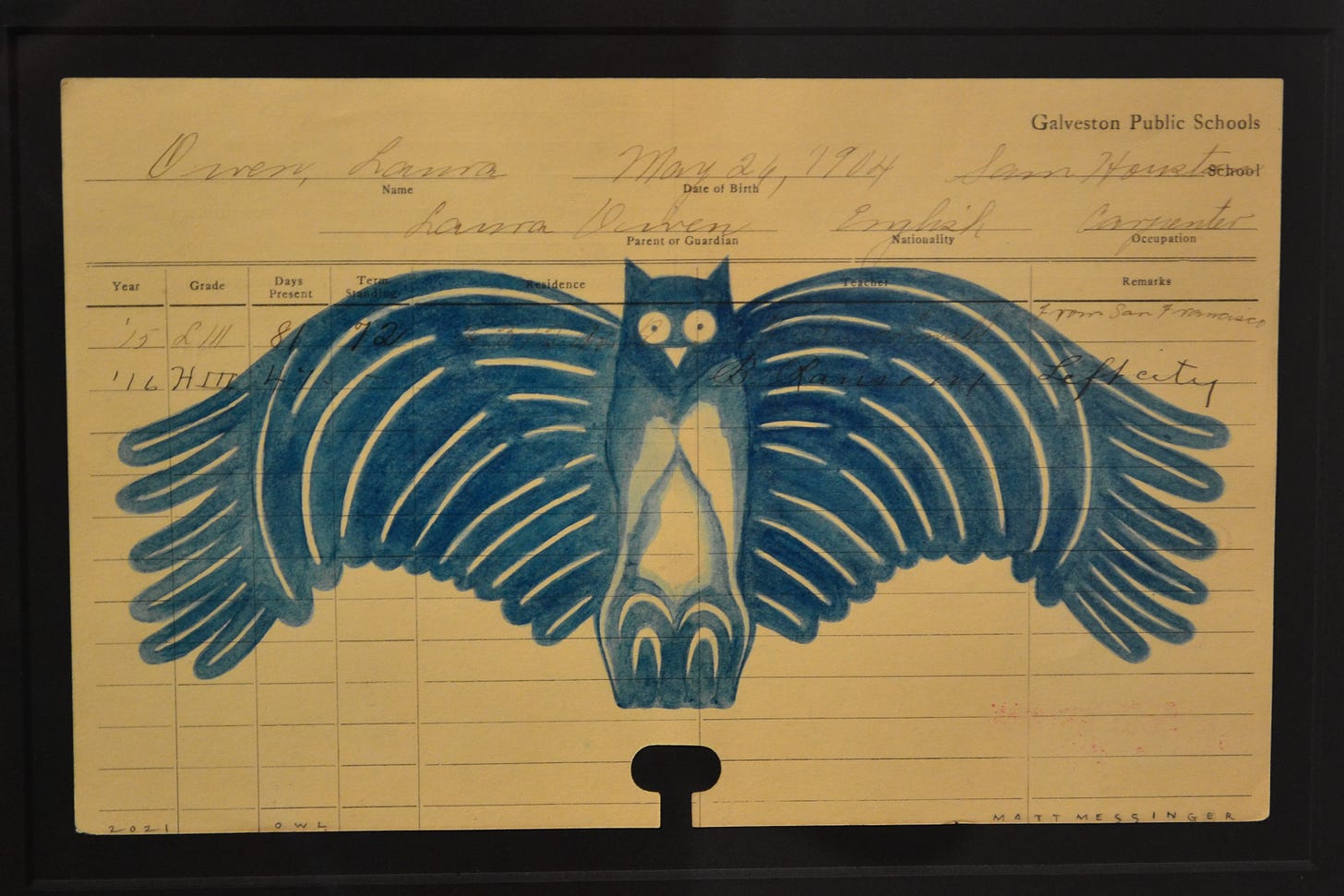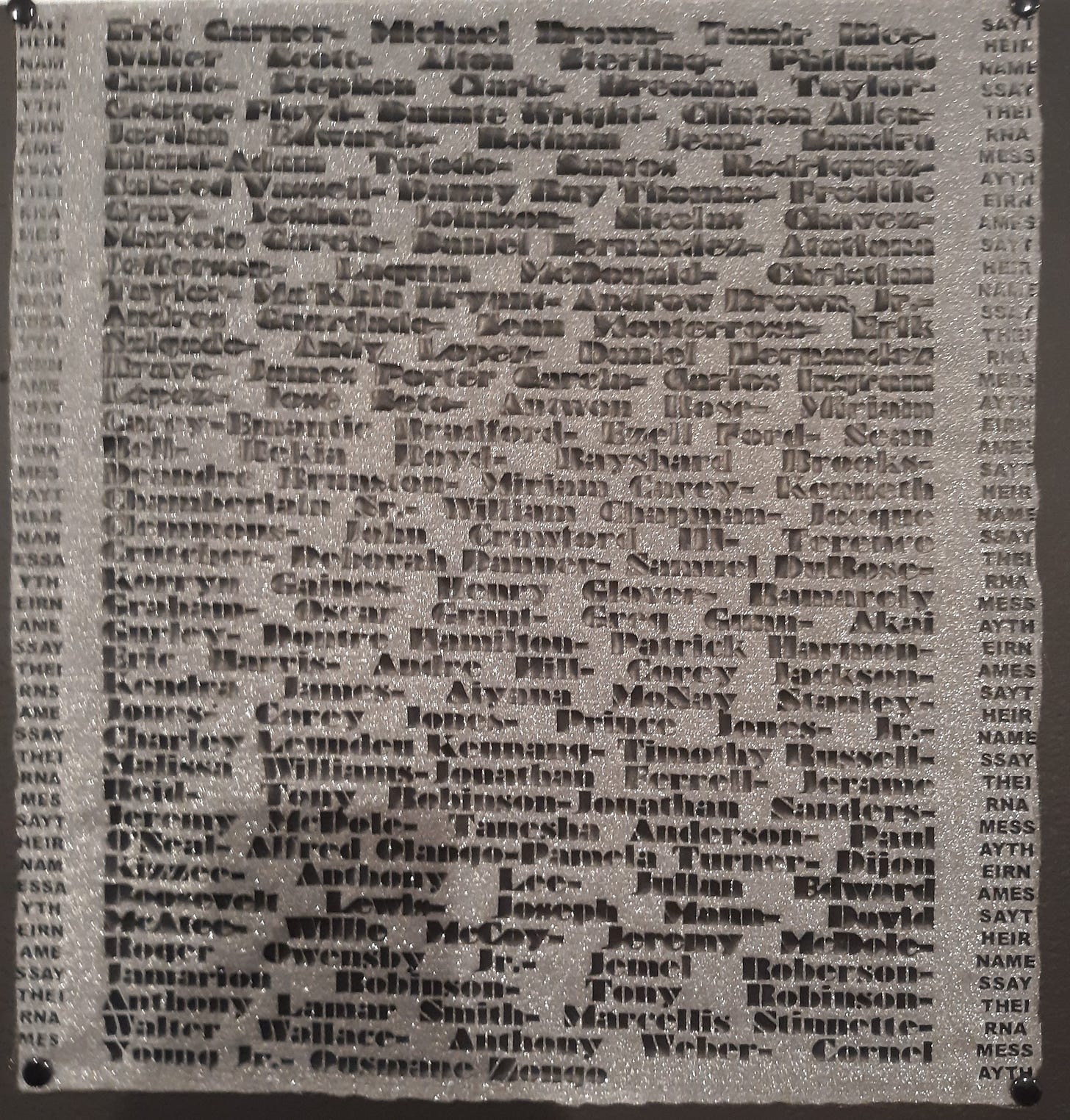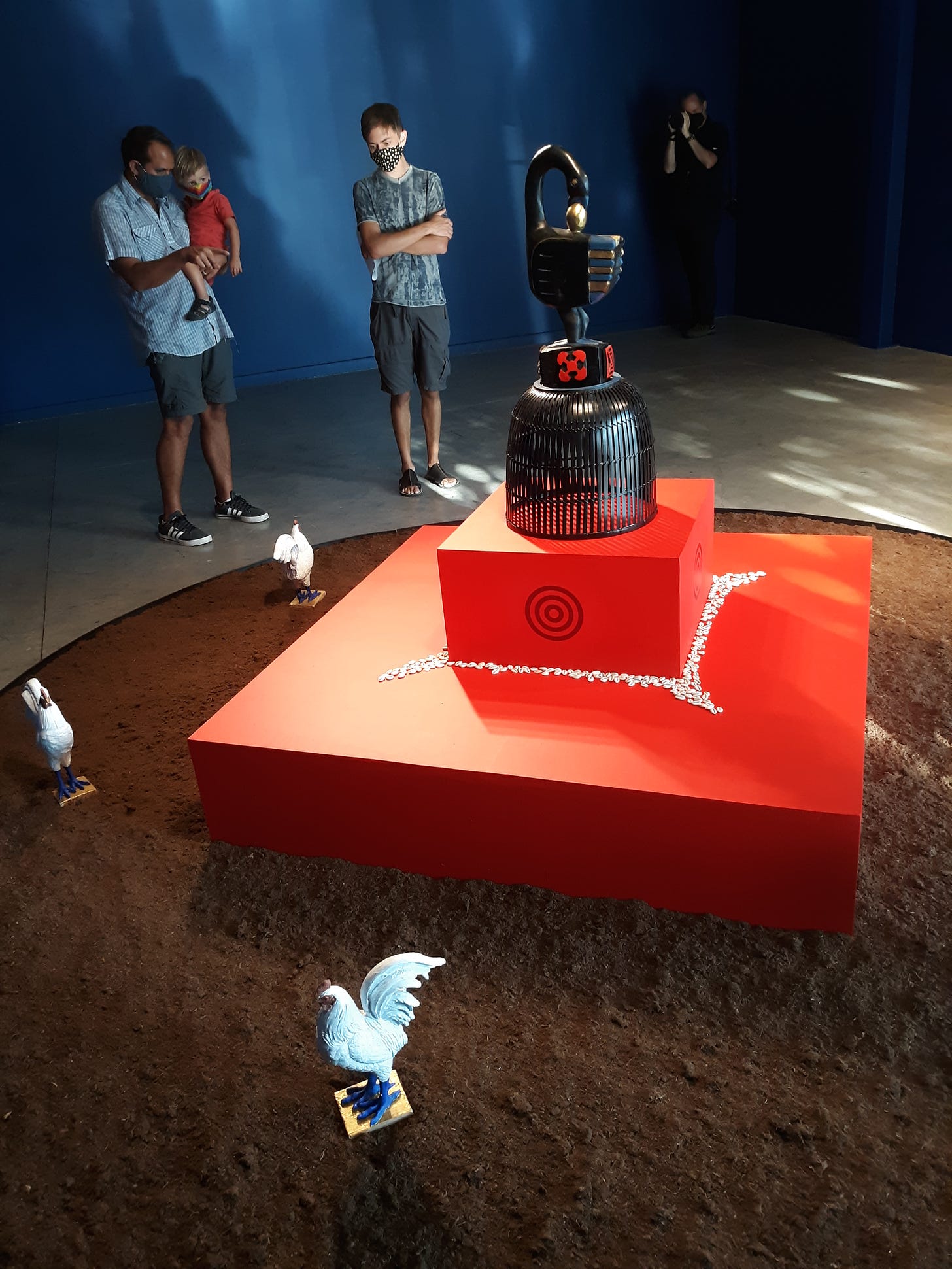Robert Boyd
In my first installment, I visited four exhibitions. In this one I shall discuss seven! This was Saturday, September 11--an auspicious anniversary. 20 years ago, 2977 people died of a terrorist attack. Now we get 1400 or so dying every day of a mostly preventable disease. And it is this disease that kept most of us collectively from going out to see art for a year and a half. But now that many of us are vaccinated and masked in public, we can venture some public art viewing. On September 11, I first went to the UH Downtown faculty art exhibit, at the O'Kane Art Gallery on campus. I've seen dozens of great exhibits here over the years, but it has a low profile amongst Houston art spaces.
Floyd Newsum, Row Houses in Red, 2018, gouache on paper
It takes a second to see the row houses in Floyd Newsum's gouache drawing, Row Houses in Red.
Patricia Hernandez, Pink Edge, 2021, acrylic and oil on clay board Patricia Hernandez got one of the worst reviews I ever wrote on this blog, back in 2011. But I love these paintings. Slashing and disturbing, with their toothy, partially open mouths.
Patricia Hernandez and I both studied art and art history at Rice, and she subsequently founded Studio One Archive Resource, devoted to preserving local art history, which is of great interest to me. Alas, Studio One Archive Resource is now defunct.
Patricia Hernandez, Untitled #3, 2021, Acrylic and oil on clay boardMark Cervenka, Past Grievances Recede Before Immeasurable Distance, 2020, oil on canvas
I don't really know Mark Cervenka or his art, but he is the director of the O'Kane Gallery at UHD. I liked this picture because of the silent watcher standing in the ruins of a recently destroyed city. It reminded me of images of Stalingrad, but, alas, there are so many destroyed cities that Cervenka could
have used as a model. (I wonder if he is related to Exene Cervenka.)
Mason Rankin, The Mint Open, 2021, found objects, automotive
Mason Rankin is another artist about whom I know nothing, but looking at his work online, this crushed car is very atypical. His website shows him to be a photographer and teacher of photography. But let artists work outside their comfort zones!. I am curious--did he crush the car himself (like John Chamberlain might have done), or did he find it this way?
Beth Secor, Exoduster, Kansas, (sometime in the 1870s), 2008, embroidery on textile
Last of all, let's look at one of the pieces Beth Secor exhibited in the show. It's an old piece from 2008, which struck me as a little odd. But one can see her new work now at a solo exhibit at Inman Gallery.
After UH Downtown, I went to a place that is in my neighborhood that I had never visited before (although I've walked by it many times). The African American Library at the Gregory School is part of the Houston Public Library System. What specifically interested me was a small exhibit they were having of artwork from the John L. Nau III Collection of Texas Art. One interesting thing they did here was to show self-taught artists alongside more academically trained artists. In other words, the insiders and the outsiders shared wall space for once. This seems especially necessary when showing the work of African-American artists since for so long, many of the greatest African-American artists were denied the training their white peers got. They weren't outsiders by choice.
 Kermit Oliver, Sunday Morning, n.d., acrylic on board
Kermit Oliver, Sunday Morning, n.d., acrylic on boardSunday Morning is one of two beautiful Kermit Oliver paintings in the show.
John Biggers, Upper Room, 1984, lithograph
And there are several choice John Biggers pieces. A few more recent pieces are part of the collection, as well.
Bert Long, Chalice, 1975, lithograph
James Bettison, Domestic Bliss, 1988, lithograph
But as I mentioned earlier, what makes this exhibit really special is the inclusion of so-called "outsider" artists as the equals of the trained artists.
Rev. Johnnie Swearingen, Cotton Picking, 1976, oil on masonite
The Reverend Johnnie Swearingen was born in Brehnam. Texas, in 1908 and became interested in painting around 1950. The way these things work is that after some time working totally outside the knowledge of the "art world", and artist like Swearingen gets discovered. These discovery stories are often quite fascinating, but what they suggest is that many Johnnie Swearingens of the world never got discovered and their work remains unknown.
Frank Albert Jones, Grandpa's Devil House, 1952, colored pencil on paper
Frank Albert Jones was a prisoner in the Texas State Prison system. He saw ghost, devils and "haints" that he drew as confined in devil houses. I wonder if that reflected the circumstance he found himself in, where criminals were confined in their cells. Here is a detail from the drawing above:
Frank Albert Jones, Grandpa's Devil House detail, 1952, colored pencil on paperNext I went over to the galleries on Colquitt, which seem to be slowly disappearing. Soon the beautiful Achitectonica building that has long housed art galleries will be the home of nothing but fancy marble floor-covering stores (which would be a case of replacing one type of high-end bourgeois retail establish with another, I guess.) First I went to Heidi Vaughan Fine Art for a solo show by Patrick McGrath Muniz. No one can deny his skill as a painter, but I was unmoved by them.
 Patrick McGrath Muniz, Diasporamus, 2018, oil on canvas
Patrick McGrath Muniz, Diasporamus, 2018, oil on canvasDiasporamus, painted soon after Hurricane Harvey, may stir a few terrifying memories for Houstonians.
Across the alleyway from Heidi Vaughn Fine Art is Gray Contemporary, which was showing two exhibits; a solo exhibit by Matthew Woodward and a small group exhibit in the back gallery. Matthew Woodward's work was some of my favorite that I saw this weekend.
Matthew Woodward, Edgecomb Boulevard, 2018, pencil, paint on paper
His work has a kind of simple idea. Find some attractive, old-fashioned architectural detail and draw it very large on paper. But because he'd drawing it white on slashing black-painted underpainting, on rough brown paper that is often torn, it makes the idea of a ruin stand out. As artworks, they remind me a little of English "Follies", gardens from the 17th and 18th century that were designed to look like ruins. I can't say exactly what I liked so much about these, but I was moved by them.
Jen Rose, Tiny Monster Under Your Bed, 2021, porcelain and nylon cord
Monique Lacey, Hyperbole Unus, 2021, bronze
The back gallery at Gray was filled with tiny sculptures, each one a only a few inches in any dimension. It was a nice little collection.
A quick stroll down the street and I was at Moody Gallery, where one of their best known artists James Drake was exhibiting a huge drawing (along with a lot of preparatory drawings).
James Drake, Can We Know the Sound of Forgiveness, 2021, charcoal on paper mounted on canvas
I've greatly enjoyed James Drake's artwork for years, but this one doesn't really move me.
In the back room, they had a small group show up.
Terry Allen, Rage, 1995, etching, aquatint, collageMelissa Miller, Forest Fire, 2019, oil on canvasI couldn't photograph either of these pictures head on because gallerist Betty Moody was in the middle of the room on a ladder adjusting the track lighting.
I next went to Hooks-Epstein Gallery. One of the biggest changes of the COVID times was the death of Geri Hooks. She cofounded the gallery in 1969, making it one of the longest lived galleries in Houston. (Texas Gallery and Moody Gallery are both up there in longevity, but I don't know which of the three is the oldest)> Hooks died in June, and I have been wondering what the future holds for the gallery. I don't know who owns it now. But it is still in business.
The currently have a small group show up. A bunch of old favorites of mine have their work on display.
Mark Greenwalt, I Spot Eye Spot, 2021, graphite, acrylic on panel
Mark Greenwalt was the subject of a post in the first year of The Great God Pan Is Dead, just over 12 years ago.
Mayuko Ono Gray, Pulsating Still Life--Composition in Green, 2021, graphite on paper
I appreciate the irony of naming a graphite drawing "Composition in Green." It was also intersting to see a Mayuko Ono Gray piece without Japanese characters woven into the composition. Here she goes for a Dutch still-life with bubbles added.
Clara Hoag, Sailor, 2021, ceramic
Clara Hoag was in the gallery that day. I asked her about the black coloring on the feet, whether it was a glaze applied before firing or paint applied afterwards. The answer was neither. The piece was apparently fired more than once and the pigment around the toes was applied between firings. (All of which is to say that I am ignorant of the techniques of ceramics.)
Ann Johnson, Buck, 2021, transfer print, embossing, found objects
I've always loved Ann Johnson's practice of printing photographic images on surfaces that normall aren't used to print photographs.
From there, I went over to McClain Gallery where Shane Tolbert was having an opening. I haven't seen Tolbert in years, because he moved away. He currently lives in New Mexico. But he was in Houston for his opening.
Shane Tolbert discussing his work, standing in front of Blood Harmony, 2021, acrylic on canvas
My memory of Tolbert's work when he was still in Houston was that is was much more pale than the work on display at McClain. This show was full of bold, brightly colored work.
Shane Tolbert, Rope Thrower, 2021, acrylic on canvasShane Tolbert, Electric Netting, 2021, acrylic on canvas
It was great to talk to Tolbert, and I was happy to see, for the second time that weekend, Tudor Mitroi.
Tudor Mitroi (left) and Shane Tolbert (right)
My last stop of the day was the concrete cube at 4411 Montrose, which houses several galleries. Two of the galleries there have been there as long as I have been writing about at in Houston. One location, David Shelton, has been there for a few years, and the other two locations are like cursed restaurant locations. No gallery seems to last long in them. One of these is currently vacant, the other is the location of Foto Relevance. Foto Relevance is a bizarre name for a gallery--the word "relevance" seems particularly out-of-place, all the moreso for the surreal exhibition on display now.
Pelle Cass, Volleyball at Northwestern University, Close, 2018, inkjet print on heavy matte rag paperPelle Cass sets up his camera over a playing field of one kind or another, takes 100s of fotos, then layers the figures and balls over one another using Photoshop.
Pelle Cass, Dartmouth Softball, 2019, inkjet print on heavy matte rag paperNext was Anna Mavromatis at Barbara Davis Gallery. I don't know Mavromatis, even though she is based in Houston, as far as I can determine. For this show, she made monoprints of dresses or even made dresses themselves that were hung from the ceiling.
Anna Mavromatis, Daybreak, 2021, old dictionary pages folded and stitched to form the bodice of a young girl's dress, cyanotypes on coffee filters
The blue and grey come from the means of making this object. The images have to do with the early 20th century struggle to gain the right to vote for women.
Benjamin Edmiston had a solo exhibit at David Shelton Gallery.
Benjamin Edmiston, Sundown, 2021, oil, flashe and wax on linen
What I liked about Benjamin Edmiston's paintings of crooked groups of parallel lines was the way they reminded me of badly stacked books--because that is the environment I live in. These would be good paintings for book-lovers. The paintings are completely abstract, but we humans like to find patterns in randomness. It's why we see images when we look at clouds.
The last gallery I'll mention is Anya Tish, and the show she had was perhaps my favorite of the weekend. It was an exhibit of new pieces by Gabriel Martinez.
Gabriel Martinez, Untitled, 2019, found fabric
As you can see, this is a piece made of fabric scraps assembled and quilted. I have to confess that I own one of Martinez's quilted fabric pieces--the most recent piece of art that I've acquired. Back in January, he sent out an email that he was raffling off a piece of art to raise money for the Houston Food Bank. I decided to take a chance and bought my $50 raffle ticket. And I won! It's a small piece, hanging on my wall right now. And it was nice to see the body of work that this small piece was a part of.
Gabriel Martinez, Channel, 2021, found fabric
This was the second rug-like piece I saw that weekend (the other being Snake by Matt Messinger). If I had either one of them, I would never walk on them.
Gabriel Martinez, Untitled, 2019, found fabric
Martinez was at the opening and we were able to have a good discussion about this body of work. When they are described at "found fabric", that is a literal description of Martinez' process. All the pieces of cloth he used were from pieces of clothing he found discarded on the street. It's weird, but if you walk around inside the city, you are almost certain to find a variety of discarded clothes. And every piece has a story that you will never know. Martinez would pick them up, bring them home, and launder them. Then he cuts them up into scraps and produces these quilts.
We talked at first about assemblage art: Robert Rauschenberg, Wallace Berman, and George Herms. Martinez had been at a residency with Herms and the two bonded. Herms is 86 years old now, and his assemblage work was produced using detritus. So Martinez is a contemporary exemplar of assemblage. But Martinez made a point to emphasize the quilting part of the work. He told me that there is a tradition of quilting in his family. Martinez is not just continuing a hundred year old artistic tradition, he is also continuing a family craft tradition.
I found these works beautiful and moving. I like them because of how they look, but also because they have a good story.
That was my Fall 2021 art season weekend.
















































